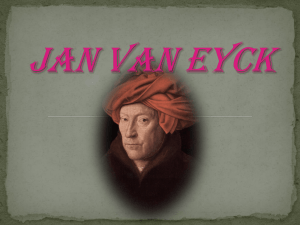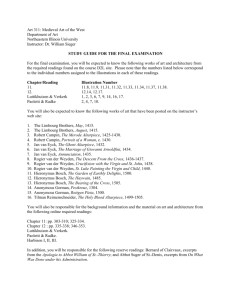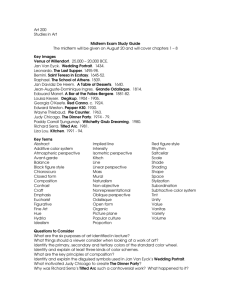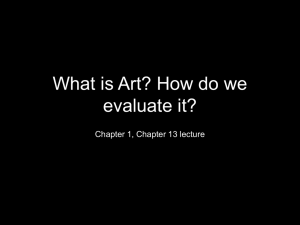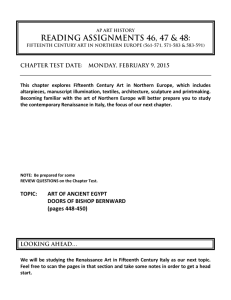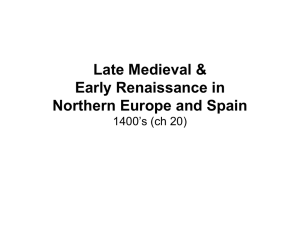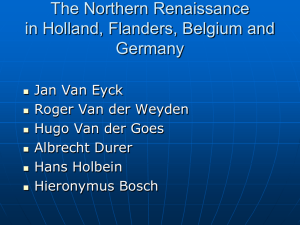masterpieces in detail - Verlagsgruppe Random House
advertisement
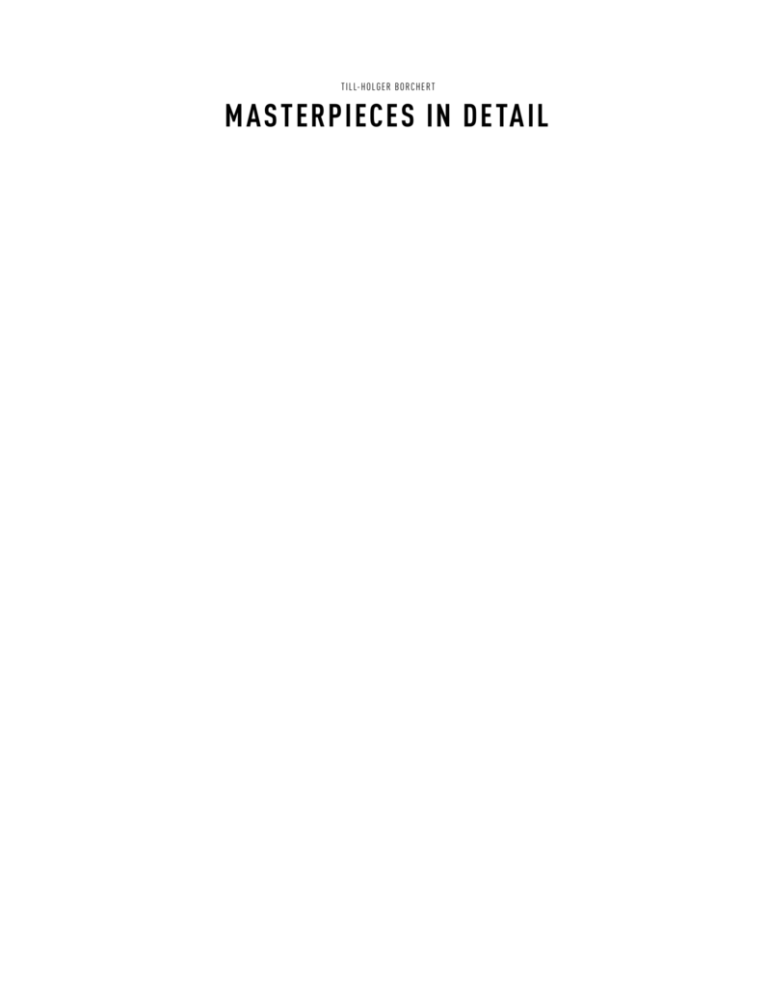
T IL L-HOLGER BORCHERT MASTERPIECES IN DETAIL TILL-HOLGER BORCHERT M A S TERPIECES IN DE TA IL Early Netherlandish Art from van Eyck to Bosch PRESTEL MUNICH • LONDON • NE W YORK CONTENTS 7 Preface 9 Foreword – Mickey Cartin 90 QUENTIN METSYS 2 292 Saint John Altarpiece 306 The Money Changer and his Wife 10 JAN VAN EYCK 12 The Ghent Altarpiece 34 Virgin and Child with Chancellor Nicolas Rolin 48 Virgin and Child with Canon Joris van der Paele 60 Saint Barbara 316 MASTER OF FRANKFURT 318 Deposition Triptych 68 ROBERT CAMPIN 70 Wings of the Triptych for Henry of Werl 338 JAN GOSSAERT 340 Danae 80 ROGIER VAN DER WEYDEN 82 Descent from the Cross 94 The Seven Sacraments 106 Saint Columba Altarpiece 346 JOOS VAN CLEVE 348 Portrait of Eleanor of Austria 120 PETRUS CHRISTUS 122 Lamentation 130 DIERIC BOUTS 132 Altarpiece of the Holy Sacrament 144 The Justice of Emperor Otto III 154 JOOS VAN WASSENHOVE 156 Crucifixion Triptych 168 HUGO VAN DER GOES 170 Adoration of the Magi 178 The Death of the Virgin 188 HANS MEMLING 190 Last Judgement Triptych 202 Saint John Altarpiece 214 Diptych of Maarten van Nieuwenhove 220 GER ARD DAVID 222 The Judgement of Cambyses 236 Triptych with the Baptism of Christ 246 HIERONYMUS BOSCH 248 Adoration of the Magi 258 The Garden of Earthly Delights 274 The Haywain 328 JOACHIM PATINIR 330 Charon Crossing the Styx, the River to Hades 354 PIETER BRUEGEL THE ELDER 356 Dulle Griet 368 The Tower of Babel 380 Winter Landscape 388 The Conversion of Paul 396 PETER PAUL RUBENS 398 E questrian Portrait of Don Francesco Gómez de Sandoval y Rojas, Duke of Lerma 406 Triptych of the Descent from the Cross 418 The Four Rivers of Paradise 428 The Garden of Love 438 ANTHONY VAN DYCK 440 ‘Le Roi à la chasse’ 450 Portrait of Carlo Emanuele d’Este with Dog 456 JACOB JORDAENS 458 The Feast of the Bean King 4 68 JAN BRUEGHEL THE ELDER 470 Allegory of the Sense of Smell 80 WILLEM VAN HAECHT 4 482 The Cabinet of Curiosities of Cornelis van der Geest 492 Bibliography 495 Acknowledgements 496 Photo credits 5 PREFACE The notion that ‘the devil is in the detail’ – as Aby Warburg (1866–1929) pointed out – is also and especially true of the fine arts. Old Master paintings rarely disclose their secrets and subtleties at first glance. In the case of ambitious, artistically and intellectually sophisticated paintings in particular, content and meaning only reveal themselves to an alert and attentive viewer who looks closely, repeatedly, and each time through fresh eyes, in order to arrive very gradually at a deeper understanding of the work in question. For this reason it is well worth taking not just one but several appreciative looks at the masterpieces of earlier epochs, so as to gain insights not only into the way they have been laid out and painted, but also into the aims and intentions of their artists. With this aim in mind, the almost 500 pages of this book present a lavishly illustrated panorama of Netherlandish painting from the 15th to the 17th century, with representative examples of the oeuvre of the respective artists. Famous names thus alternate with painters who are less well known, whereby the focus falls above all on the unparalleled holdings in Flemish museums and churches and in the collections assembled by the Habsburgs, trad­itionally closely linked with the Burgundian Netherlands, which are today housed in Vienna and Madrid. In order to avoid possible misunderstandings, let me briefly clarify the term ‘Early Netherlandish’, which underlies the selection of artworks in this book. ‘Early Netherlandish’ does not refer in any way to the modern-day Kingdom of the Netherlands, but is used in a historical sense to describe the art produced in the princedoms, such as Flanders, Brabant and the Hainault, ruled in personal union in the 15th century by the Duke of Burgundy Philip the Good (1396–1467), his son Charles the Bold (1433–1477) and their Habsburg heirs up to Emperor Charles V (1500–1558). These princedoms lay in the south of the Burgundian Netherlands and correspond to the today primarily Flemish regions with the cities of Bruges, Ghent, Antwerp, Brussels and Leuven – international me- tro­p­olises even in the 15th and 16th centuries. Geographically speaking, these territories were thus more or less identical with the national borders of Belgium. The majority remained Catholic even after the revolt of the Calvinist provinces of Holland, Zeeland and others in the north and the subsequent creation of the republic of the united Netherlands (1579/81). They were ruled from the middle of the 16th century onwards by Philip II of Spain (1527– 1598) and subsequently by governors drawn from the Spanish branch of the house of Habsburg, and from the 18th century up to the Napoleonic invasion by members of the Austrian Habsburg line. All the paintings included in this book were produced within approximately 200 years and hence within a politic­ ally and culturally extremely eventful period of history, during which the way that artists perceived themselves, their role and their status underwent a fundamental change, the objective realism of smoothly polished surfaces was replaced by the subjective, virtuoso signature of the impasto brush stroke, and – against the backdrop of ecumenical councils and the Reformation – the painting evolved from primarily religious cult object to autonomous artwork. Over the course of these two centuries, the works produced in the Low Countries by artists such as Jan van Eyck, Hieronymus Bosch, Pieter Bruegel the Elder and Peter Paul Rubens regularly influenced the course of Europ­ean art with their innov­ ations. With regard to the development of portraiture and landscape painting in particular, Early Netherlandish masters from van Eyck to Bruegel and their Flemish descendants Rubens, Jacob Jordaens and Anthony van Dyck set new standards that earned the admiration of contemporary writers and attracted the covetous attention of the most important patrons and art collectors of their day. The texts are aimed at interested readers and provide biographical information about each painter, as well as situating his artistic achievements in context. They present the selected works in a succinct manner and, lastly, examine ­certain details a little more closely. This book does not presume to tell readers what to look at or how these masterpieces should be seen. Instead, the descriptions are intended to encourage viewers to make their own personal discoveries and to experience the timelessness of these paintings by the Early Netherlandish masters. I would have greatly liked to allow contemporary artists to testify to the enduring relevance of the Old Masters, but that lies beyond the scope of this already opulent volume. I am therefore all the more grateful for the opening words by Mickey Cartin, one of America’s most important private collectors, who – with a discerning eye for quality – collects works by contemporary artists as well as Old Master paintings. TILL-HOLGER BORCHERT 7 FOREWORD The author of this book has been a friend of mine for some time, and I was a bit humbled that he would ask me to provide a foreword here. He is, after all, an accomplished art histor­ ian and exhibition maker, and I am an ‘amateur’. I have a deep interest in the history of art, but after years of looking and indulging my endless curiosity, my knowledge remains rather sketchy and my ability to recall the limited amount of information I have collected is often unreliable. On the contrary, I have marvelled at Till-Holger Borchert’s deep knowledge of the history of art. His focus is on Early Netherlandish Painting, but he has a strong grasp of the history of art from the Gothic to the present, and when I first met him I could not understand how so much information could reside in one head, nor could I believe the facility with which it could be retrieved. He has reminded me that while my achievement as a historian is modest at best, my enthusiasm for art and for looking at pictures is limitless. When I first saw this book, I started counting and noted that I had at least once in my life stood before all but seven of these masterpieces. As I looked a little more carefully at the figures in the pictures – each of them has at least one human figure, and some have hundreds – I realized that I already had met them all before, but that my memory of them was not as clear as I would like. I did not see them as long lost friends, or as dead relatives from my youth, but instead recognized that they had become for me eternal, ­emotive symbols of the imaginary universe that is art. And more, I knew that I was seeing again some of the most profound and powerful figures ever wrought in that universe. I will give a couple of examples. And so it is with enthusiasm that I look at the pictures published here and share my experience with you. I write this on the last of seven consecutive days of one- to two-hour ­visits to the Museo del Prado, in which a number of the mi­ra­cu­ lous entries in this book reside. Allow me to pass on to you my experience with a few of the characters that I have encountered face to face in one of those paintings over the past days. On each of those visits I felt my heart rate increasing as I waited in line for entry to the Prado. Each time I went first to Rogier van der Weyden’s Descent (p. 83). It is too much of a miracle of illusion to take in all at once, and I spent 20 minutes or so on my first encounter before I felt two polar­ izing pushes. On the one hand, I could not get enough of them, while on the other, I needed to move on – quickly. This is not how scholars react to pictures, I thought. They stay in place. They look, and look harder. They compare with others by the same author, either side by side or from memory, but they always compare. I just react. I am not a connoisseur. I am just an enthusiast, but informed enough to know that this is one of the greatest paintings in all of the history of art, and within its boxed-in stage-like space is a group of the most emotionally despairing people ever assembled in a picture. Enthusiasts are always making claims like this. ‘I know, I know, Jesus is dead,’ I thought to myself, and ‘What do you expect?’ For the next six days I returned to share the grief of the players. I absorbed their interconnected hurt and pain. Be- t­ween shakes of the head in my amazement over what I was seeing, I felt very saddened. I might have even cried a bit, not over the suffering and death of Jesus, but in response to the pain of those who witnessed his removal from the Cross. Each day I stayed for as long as I could take the mourning and grief, and then I fled. Each day I was alternately pulled to this monumental picture, and soon after I was repelled. As always, I realized that one can have this kind of response to a ­picture without the benefit of scholarship, and I was encouraged yet again by that awareness. What you have in this book are beautiful, faithful reproductions of a grouping of the greatest paintings you could ever see. You also have commentary by a great scholar, and one who loves pictures with intensity. This is a good beginning, or a good reminder, or both. If it is your first encounter with these paintings, go see them. If seeing these pictures in this book reminds you of the absolute thrill of the experience of standing before them, go see them again. Books like this are wonderful things, but remember to go look at the pictures. If you are an amateur like I am, or a novice who is seeing them here or the first time, do not be afraid to look. Then keep looking until the miracles become yours. MICKEY CARTIN 9 JAN VAN EYCK * c. 1390 – † 1441 Portrait of Giovanni Arnolf ini and Jeanne Cenami 1434 Londen, National Gallery Portrait of the Goldsmith Jan de Leeuw 1436 Vienna, Kunsthistorisches Museum 10 Jan van Eyck, who ranks among the founders of Early Netherlandish painting, revolutionized European art with representations that are impressively realistic even by today’s standards. With its naturalistic landscape background and astonishing accuracy of detail, the Ghent Altarpiece (pp. 12–33), begun by his brother Hubert († 1426) and completed in 1432 by Jan and his assistants, is considered a pioneering work of Early Modern painting. Jan van Eyck was probably born around 1390 in the town of Maaseyck in the county of Loon. Where he learned his craft is unknown, but it is likely that the painter was trained together with or by his elder brother. His works also testify to a close study of the art being produced at the French royal court during the years around 1400, so that it is plausible that also he spent time in Paris at an early stage of his career. Jan van Eyck is first documented in 1422 in The Hague, where together with assistants he executed decorations for the Binnenhof palace of John III, Duke of Bavaria-Straubing (1374–1425), the former prince-bishop of Liège and, from 1418, Count of Holland and Zeeland. Van Eyck appears to have served as a painter to the ducal court and in 1424 is explicitly described as such in documentary sources. After the sudden death of John of Bavaria, in January 1425 van Eyck left Holland and went to Bruges. In May of that year he was appointed court painter to Philip the Good (1396–1467), Duke of Burgundy, and awarded a generous annual pension. At the duke’s behest, Jan van Eyck relocated to Lille, the administrative centre of the Burgundian Netherlands, where he rented a house. From 1425 to 1429 he seems to have run a workshop here, and in 1427 and 1428 attended the formal dinners held by the Guild of St Luke in Tournai, at which Robert Campin (pp. 68–69) and Rogier van der Weyden (pp. 80–81) were also present. During his time in Lille, Jan van Eyck undertook secret commissions for the duke that took him for lengthy periods to ‘certain distant lands’. In 1429, for example, he was part of a Burgundian embassy that travelled to Portugal to ­broker the marriage between Philip the Good and the Infanta Isabella of Portugal. On that occasion van Eyck made a portrait of the bride that was sent back to Philip the Good. Soon after his return from Portugal in December 1429, the painter seems to have taken up work on the Ghent Altarpiece, left unfinished by his brother Hubert after his death in 1426. Probably even before he had finished the Ghent polyptych, Jan van Eyck moved to Bruges, where he set up his workshop in the wealthiest part of town no later than 1432. The painter and his assistants immediately received a visit from the city councillors and soon afterwards from the duke and his retinue. It was in Bruges, between 1432 and 1441, that the few extant paintings confidently attributed to Jan van Eyck were produced. In 1432 the artist completed the Portrait of a Man (‘Léal Souvenir’) and the following year the Man in a Red Turban, probably a self-portrait (both London, National Gallery). In these fully-fledged examples of van Eyck’s portraiture, the sitters appear in half-length view against a neutral background and are seen in three-quarter profile, turned towards the left. The artist has paid particular care to reproducing the fall of the light, which also heightens the modelling of the faces. This desire to achieve a sculptural, three-dimensional effect is particularly clear in his portrait, dated 1436, of the goldsmith Jan de Leeuw, who looks directly out at the viewer and at the same time addresses us through the inscription on the original frame. Identical characteristics are found in van Eyck’s last portrait, produced in 1439 and showing his then 33-year-old wife, Margaret, whom Jan married at the latest in 1432. Margaret bore him two children and continued to run the artist’s workshop for some time after his death. Van Eyck’s clients included Bruges city council, on whose behalf he gilded and painted sculptures on the front of the town hall in 1435, and – in particular – merchants and businessmen from Italy. His famous Arnolfini Portrait of 1434 was painted for Giovanni Arnolfini, an Italian merchant from Lucca who was at that time living in Bruges, and was probably intended to commemorate Arnolfini’s deceased wife. An Italian patron – a member of the Giustiniani family belonging to the Genoese patriciate – likewise commissioned the small 1437 Triptych of the Virgin and Child, which will originally have served as a portable altarpiece. Although Philip the Good evidently permitted Jan van Eyck to accept private commissions, too, at the latest from 1432 onwards, the Duke of Burgundy con­ tinued to employ the services of his court painter on a regular basis. In 1432, im­ mediately after the artist’s arrival in Bruges, he was thus ordered for several weeks to Hesdin, probably to decorate the ducal palace. In 1435 the duke dispatched his painter to the peace conference at Arras, where van Eyck probably made portraits of the delegates, including a sketch of the papal legate, Cardinal Albergati. The following year the artist embarked on one last secret mission for the duke and was generously rewarded for his efforts. At the same time, he also acted as Philip’s agent, for example commissioning manuscript illustrations on the duke’s behalf. In the spring of 1441 Jan van Eyck died in Bruges and was buried in St Donatian’s Church at the behest of his younger brother, Lambert van Eyck, who was evidently a member of his Bruges workshop. Triptych of the Virgin and Child 1437 Dresden, Gemäldegalerie Portrait of Margaret van Eyck 1439 Bruges, Groeningemuseum 11 JAN VAN EYCK The Ghent Altarpiece 1432 Oil on panel, 375 x 260 cm (wings closed); 375 x 520 cm (wings open) Ghent, Sint-Baafskathedraal On twelve panels containing a total of 26 individual scenes, the Ghent Altarpiece unfolds a painted compendium of the Christian message of salvation, from the first man and woman to the incarnation of God and the Heavenly Jerusalem of Reve­ lation. The monumental polyptych was part of a large-scale endowment by the Ghent patrician Joos Vijd († 1439) and his wife, Elisabeth Borluut, to St John’s Church (today St Bavo’s Cathedral) in Ghent and was originally installed on the All Saints altar in the Vijd family chapel off the choir. The endowment, which made provision for daily Masses to be said for the souls of the donors and their forebears, lasted right up to the ancien régime and was only abandoned in 1797 during the French occupation of Flanders. The Ghent Altarpiece, completed in 1432, is the largest, most multifaceted and by far the most complex work by Jan van Eyck and his mysterious brother Hubert. It also bears the ­earliest tangible witness to Jan van Eyck’s activity as an artist and ranks among the founding works of European painting of the Early Modern era. The representations on the exterior and interior alike are divided into two horizontal zones. This layout, coupled on the feast-day side with a striking discrepancy in scale between the upper and lower register, for a long time obscured the theologically complex but nonetheless cohesive relationship of all the elements represented on the Ghent Altarpiece. The five panels of the lower register on the interior, feast-day side may be seen as a continuous succession of all the saints. Confessors, martyrs and saints and the prophets and patriarchs of the Old Testament and non-Jewish peoples of the world are assembled on the central panel, while the wings show the Righteous Judges, the Soldiers of Christ, the Hermits and lastly the Pilgrims. The countless saints – of whom only a few, such as James the Greater and Christopher, can be identified from their attributes – form the community of the blessed to whom Paradise is promised. They are situated in a sweeping paradise landscape with the vedutà of a city in the background. Although some of the buildings are based on real-life works of architecture (the collegiate church of Great St Martin and Cologne’s unfinished cathedral can be both be recognized), this is a vision of the New Jerusalem, described by Saint John 12 the Evangelist in his Book of Revelation. The lower register can therefore be read at the same time as an illustration taken from Revelation. The apocalyptic Lamb, blood flowing from its breast into a chalice, stands on an altar in the centre. The mystic Lamb is the object of adoration of the saints approaching from all four points of the compass and a symbol of Christ and his death and Resurrection. It points in demonstrative fashion to the sacrament of the Eucharist in the celebration of Mass and thus to the promise of salvation offered in the New Testament. These two aspects are further underlined by the angels grouped around the Lamb, who present the instruments of the Passion and swing incense burners. Below the Lamb in the central foreground is the fountain of life described in Revelation, which represents a symbol of the Christian baptismal font. The motifs of the Lamb and the fountain illustrate that only those who receive the sacrament of Baptism can participate in the Eucharist and thus in the redemption promised by Christ’s sacrifice. The water flows out of the fountain of life through a head at the bottom of the octagonal basin and feeds the river of life, a symbol of the New Jerusalem. In the upper register on the feast-day side, the naked figures of Adam and Eve refer to the original sin that precipitated humankind’s fall from grace and consequently its need for redemption through Christ. God’s promise of divine grace on the Day of Judgement is given implicit shape in the triune figure of God between the Virgin and Saint John the Baptist – a constellation in which van Eyck references the deësis group that was a traditional feature of medieval representations of the Last Judgement in the Low Countries. Unlike these latter, however, the Ghent Altarpiece does not explicitly show the motif of intercession: contrary to pictorial convention, the Virgin and the Baptist are not shown interceding for the souls of the dead on the Day of Judgement, but seem to be immersed in a study of the scriptures and wear a contemplative air. The Virgin is identified as the Queen of Heaven by the magnificent crown on her head and is characterized by verses taken from the Wisdom of Solomon and recited as part of the prayers of the Office of the Assumption: ‘For she is more beautiful than the sun, and above all the order of stars […] For she is the brightness of the everlasting light, the unspotted mirror of the power of God’ (Wisdom 7:29/26). John the Baptist is likewise described by Latin inscriptions on the gilt arches behind him as ‘greater than man, equal to the angels, sum of the Law, voice of the Apostles, silence of the Prophets, light of the world, witness of the Lord’. The deësis group in the upper zone is flanked on either side by angels making music and singing. The majolica tiles – which in van Eyck’s day were imported into the Low Countries from Valencia – are decorated with the monogram IHS, the Greek alpha and omega as another abbreviation for Christ, and the stylized Lamb. They subtly suggest that the room in which the angels are assembled belongs to a plane of reality different to that inhabited by the deësis figures. At the same time, however, an association with the Last Judgement is evoked by the motif of Saint Michael vanquishing the dragon, visible on the wooden lectern. If the interior, feast-day side of the Ghent Altarpiece represents the fulfilment of the divine plan for Christian salvation, with the advent of the kingdom of the Heavenly Jerusalem, the exterior, everyday side shows its beginning. The lower register of the closed altarpiece consists of four niches containing the two donors and – painted to look like stone sculptures – Saint John the Baptist and Saint John the Evangelist. The upper zone shows the Annunciation, the event with which the Christian message of salvation begins and which is here set in a room in a tower and extends across all four panels. The Archangel Gabriel on the left is approaching the Virgin kneeling at prayer on the right, the dove of the Holy Ghost above her head. The buildings of a town can be seen through the arched window openings in the background, bringing the biblical scene into the real world of the viewer. The room itself contains still-life arrangements of everyday objects, which here assume an allegorical significance. The small glass bottle on the windowsill, for example, was a popular symbol of Mary’s virginity, while the lavabo set into the niche resembles liturgical items used during the celebration of the Mass. In this way the Virgin’s significance as Ecclesia – the Church – and as the altar of God is underlined. In the uppermost register, the two Old Testament prophets Micah and Zechariah appear to the left and right of the Cumaean and Erythraean sibyls. These four half-length figures seem to lean out in three-dimensional fashion from their illusionistic spandrels. They are accompanied by banderoles whose inscriptions prophesy the coming of the Messiah as the future king of the world. This topmost zone can therefore be interpreted overall as heralding the promise of salvation that starts with the Annunciation underneath and is fulfilled in the advent of the kingdom of God on the interior of the altarpiece. 15 16 A paradisiacal world On the panel of the Adoration of the Lamb, the dove of the Holy Ghost appears in the centre of the heavens, concentric beams of light radiating from its body (p. 33). In the foreground, the rays descend upon the company of saints approaching from all sides, who include a number of Old Testament and pagan authorities – the figure in the laurel wreath possibly represents the Roman poet Virgil – with strikingly indiv­ idual faces (p. 28). Although the golden rays were painted on the top of the completed landscape, they form part of the original pictorial concept. On account of its distinctive octagonal lantern, the tower on the left can be identified with the bell tower of Utrecht Cathedral, one of the most import­ ant church towers in the Low Countries (p. 16). For a long time this detail was thought to have been added by the Utrecht Renaissance artist Jan van Scorel, during his restoration of the altarpiece in 1550. In fact, however, it was Jan van Eyck himself who incor­ porated the Utrecht Cathedral tower, just like the still unfinished Cologne Cathedral, into this vedutà of the Heavenly Jerusalem set within a paradisiacal landscape. Van Eyck takes enormous pains over the very smallest details: even the hair on Adam’s body is rendered so carefully that we can count each individual hair on his brow as well as his beard and even his pubic hair (pp. 18, 19). By means of such seemingly veri­ fiable realism, van Eyck’s painting lays claim to a truthfulness that, overall, it does not possess. Its ­surrogate character, by contrast, dominates the representation of precious jewels and sumptuous textiles. Van Eyck emulates the sheen of heavy brocade fabrics by imitating gold thread with extremely thin brush strokes (p. 25). With exquisite care, he creates the reflections and refractions of the light on each individual pearl, jewel and crystal. In the medium of painting, these costly objects, which adorn the lavishly embroidered hems of the robes worn by the Virgin, Saint John the Baptist and most especially the enthroned figure of God, reflect treasures of immeasurable worth. Particularly impressive is the painterly perfection with which van Eyck has rendered the gemstones on the magnificent clasp of God’s cloak (p. 23). Van Eyck’s representations of the two choirs of angels are a unique document of musical perform­ ance practice in the Low Countries in the Late ­Middle Ages. The angels, wearing magnificent liturgical robes, are grouped around a wooden lectern bearing a book of choral music in mensural notation (pp. 20–21). Through the different positions of their mouths and their variously furrowed and smooth foreheads, the artist shows that the angels are singing different vocal parts of a composition with mul­ tiple melodic lines, as performed in the Low Countries at that time. Franco-Flemish polyphony – also known as Ars nova – was a modern development by composers such as Guillaume Dufay and Gilles Binchois, contemporaries of van Eyck who were active in the Burgundian Netherlands. While we are well acquainted with the polyphonic settings of choral music by Franco-Flemish composers, we know little about their instrumental accompaniment, which it was not yet the practice to codify in manuscript form. Van Eyck’s representation of music-making angels nevertheless conveys a vague idea of the instruments that accompanied such polyphonic singing (p. 24): we can recognize an organ, a harp and a viol. One of van Eyck’s most significant innovations as an artist lies in his landscape painting. The Ghent Altarpiece is one of the earliest examples of aerial perspective, a phenomenon that would only be described decades later by Leonardo da Vinci (1452–1519), whereby the further away the landscape lies from the viewer, the paler it appears (p. 33). Van Eyck translates this optical effect in masterly fashion into the background landscape of the Ghent Altarpiece, virtually blending the peaks of the distant mountains into the blue of the sky in the Soldiers of Christ (p. 30), for example, and in the Hermits panel (p. 31) suggesting the distant s­ ilhouette of a city in pale blue. According to a theory first voiced in the 16th century, the panel with the Righteous Judges may contain cryptoportraits of Hubert and Jan van Eyck. The origi nal was stolen in 1934 and remains lost. Since the 1950s its place has been taken by a copy made by the Brussels art restorer Jef van der Veken. 17 18 19 20 21 22 23 24 25 26 27 28 29 30 31 32 33 JAN VAN EYCK Virgin and Child with Chancellor Nicolas Rolin c. 1435 Oil on panel, 66 x 62 cm Paris, Musée du Louvre, inv. 1271 Jan van Eyck, court painter to Philip the Good, executed the almost square panel around 1435 on behalf of the Burgundian Chancellor Nicolas Rolin (1376–1462). Rolin, who was born in Autun in Burgundy and came from relatively modest, middle-class circumstances, studied law and subsequently served as an advisor to John the Fearless. After the latter’s murder in 1419, Rolin rose to became one of Philip the Good’s most trusted supporters. In 1422 the duke appointed him Chancellor of Burgundy and thus chief administrator of his territories. Shortly afterwards he elevated Rolin to the nobility. Rolin’s skills as a negotiator made him so indispensable to ducal diplomacy and the running of Burgundian affairs that the powerful chancellor for a long time exerted a dom­ inant influence upon Burgundian politics. Rolin thereby never lost sight of his own interests, with the result that he numbered among the wealthiest men at the Burgundian court. He purchased large estates in Burgundy and Hainault, whose revenues generated enormous sums. In 1443, when Rolin founded the famous Hôtel-Dieu hospital and almshouse in Beaune, he not only commissioned Rogier van der Weyden to furnish its chapel with a monumental Last Judgement altarpiece, but made long-term financial provision for the hospital by transferring a number of his vineyards to its ownership. Van Eyck’s painting was very probably intended for the church of Notre-Dame-du-Chastel in Autun, where since 1429 Nicolas Rolin had been liberally financing the renovation and extension of the family chapel built by his maternal forebears. In 1434 Rolin obtained papal dispensation for himself and his wife to celebrate Mass during Matins; in 1436 the chancellor made an endowment to fund chaplaincies for this purpose and regulated the order of service. By this point in time at the latest, van Eyck’s painting was probably already finished and installed in Autun. The almost symmetrical composition shows the chancellor kneeling in prayer before the Virgin and Child. The donor, seen almost in profile, is wearing a sumptuous brocade coat trimmed with fur; a book of hours lies open on the prie-dieu before him, which is draped with a velvet cloth. The Virgin is enthroned on a seat inlaid with costly intarsia, on top of which lies a brocade cushion. She is swathed in a red cloak whose hem is trimmed with precious stones and pearls and bordered with verses, worked in gold thread, that can be identified as excerpts from the Officium Parvum, the prayers recited at Matins as part of the Little Office of the Blessed 34 Virgin Mary. An angel holds the crown of the Queen of Heaven over the Virgin’s head (pp. 46–47). The naked Infant Christ is seated on his mother’s lap, holding a crystal orb in his left hand and with his right hand raised in blessing (pp. 42–43). Both motifs are firmly associated with the pictorial type of Christ as ­Salvator Mundi (saviour of the world). They serve here as a reminder of Christ’s death and Resurrection and thus symbolize the Christian promise of redemption. The four capitals with a figural décor in the background are ­likewise symbolic in meaning: depicting the Old Testament scenes of the expulsion of Adam and Eve from Paradise (p. 36), the sacrifice of Cain and his murder of his brother Abel, the story of Noah and lastly, on the right, the meeting between Abraham and Melchizedek, they take up the themes of sin, sacrifice and forgiveness and point typologically to the ­promise of redemption embodied by Christ. Van Eyck locates the scene within a sacred interior whose perspective depth is defined by the floor tiles, which appear to lead away towards a single vanishing point. The most striking feature of the room is the arcade of three rounded arches, which – like the porphyry columns – can be read as an architectural designation of majesty and are related to the heavenly realm in the background. The arcade runs behind the protagonists and offers a view of a walled paradise garden containing magpies, peacocks and two figures. These serve as repoussoir motifs and are intended to draw our gaze towards the landscape background, whose horizon has been consciously aligned to coincide with the height of the Virgin and donor’s heads. On the far side of the battlements, a panoramic river landscape leads away from the town, with its buildings on both banks, towards the snow-capped mountain peaks in the far distance. Conceived and executed with meticulous care and in the finest detail, the background landscape of the Virgin and Child with Chancellor Nicolas Rolin undoubtedly ranks among the most impressive examples of Early Netherlandish landscape painting. It is easy to understand the enormous admiration in which van Eyck’s landscape painting was held by contemporaries such as the humanist Bartolomeo Facio, born around 1400 in La Spezia. Writing about van Eyck’s now lost painting of women bathing owned by Ottaviano della Carda, the Italian noted that it showed ‘moreover horses and people on a miniature scale, mountains, forests, lands, castles, painted with such extraordinary skill that you would imagine they were more than fifty miles away’. 36 A boundless love of detail Jan van Eyck shows himself in his oeuvre to be a keen-­ eyed observer of everyday life who at the same time reflects upon perception itself. He also regularly demonstrates a striking interest in the stylistic forms and artistic vocabulary of earlier epochs. In the Virgin and Child with Nicolas Rolin, this aspect of Jan van Eyck’s art emerges particularly clearly in figural and ornamental elements of the interior decoration (p. 36). In the ornamental interlacing bands decorating the capitals of the two left-hand columns, for example, in which complex vegetal structures fuse with anthropomorphic and zoomorphic motifs, the artist takes up decorative elements of Romanesque church architecture, familiar to him from Burgundian and even Netherlandish churches. This recourse to the past is not an end in itself, however, but allows van Eyck to characterize the interior as part of a venerable sacred space. The figural capitals are likewise Romanesque in style. The artist thus characterizes the biblical events that took place in pre-Christian times, before the epoch under grace, as archaic and antiquated. On these capitals van Eyck illustrates several scenes from the Old Testament, including the expulsion of Adam and Eve from the Garden of Eden and the rejection of Cain’s offering prior to his murder of his brother Abel. These seemingly incidental and subsidiary scenes underline the necessity of Christ’s incarnation and death in order to secure the redemption of humankind. Van Eyck portrays the powerful Burgundian Chancellor in a seemingly true-to-life manner: as well as his shaved temples and the stubble on his chin, we can even make out individual veins on his forehead (p. 38). In fact, however, the artist seems to have made Rolin, who was about sixty when the picture was painted, look younger than his years. The donor’s relatively smooth face presents a marked contrast to his furrowed and wrinkled hands, which seem to correspond more closely to his actual age (p. 39). It is possible that Rolin himself insisted that the artist immortalize his face as ageless, for the chancellor was probably behind no fewer than two significant alterations made to the composition while it was still in progress. Firstly, van Eyck omitted the representation of a purse that originally hung from Rolin’s belt and was probably intended to symbolize the chancellor’s wealth. Secondly, van Eyck had not initially planned to show the donor being blessed by the Infant Christ (pp. 42–43). Was it the chancellor’s vanity that prompted the artist to include two peacocks in the background? One of the peacocks is perched on the battlements, while the second is strutting along the wall-walk on the far side of the arcade. The wall marks the boundary of a flower garden situated high above a densely populated city (pp. 40–41). Two figures, dressed in the fashion of van Eyck’s day, are also standing in the garden: a man seen in rear view, wearing a pale red coat and a black chaperon, is looking through a gap in the battlements down onto the city, river and landscape below, and possibly at his own reflection in the water, while a second man in a blue coat and a red turban stands beside him, leaning on a stick. His view is blocked by the masonry, however. Although the precise significance of these two figures remains elusive, they can probably be interpreted as painted commentaries on perception, whereby the right-hand figure, whose view is restricted and who would therefore have to rely on the figure on the left to describe the panorama for him, is sometimes viewed as a self-­ portrait of the artist. Van Eyck’s background landscape is a breath-­ taking tour de force of painterly skill. Only when we look more closely do we realize that the detailed landscape does not unfold naturally from the foreground, but that it starts abruptly behind the battlements (pp. 40–41). In front of the snow-capped peaks of a mountain range rising on the horizon in the airy distance, the traffic on the river is reflected in its waters. Large towns have sprung up on both banks, their buildings depicted in such detail that it is tempting to speculate what city van Eyck based them on. Despite the seemingly painstaking illustrations of countless churches and monasteries, harbour facil­ities and fortified towers, for which the artist has un­doubtedly drawn upon first-hand experience, the landscape is probably ultimately a product of his im­agination. 37 38 39 40 41 UNVERKÄUFLICHE LESEPROBE Till-Holger Borchert Masterpieces in Detail Early Netherlandish Art from van Eyck to Bosch Gebundenes Buch mit Schutzumschlag, 496 Seiten, 30x39 350 farbige Abbildungen ISBN: 978-3-7913-8109-1 Prestel Erscheinungstermin: September 2014 Forty works by early Netherlandish masters from van Eyck to Bosch—reproduced in exquisite detail—are the subject of this breathtaking book that leads readers deep into the paintings to reveal each artist’s astonishing technique and brilliant application of color.
